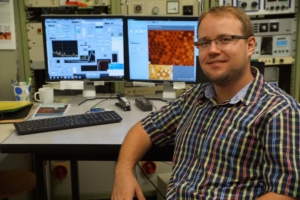/ News, Portraits
Jan Nowakowski becomes the first graduate from the SNI’s PhD school

In 2013, the first doctoral students at the SNI’s newly established PhD school started work on their research projects. Jan Nowakowski was one of them. Now he has become the first to complete his doctorate.
Understanding nature
Jan Nowakowski was born and grew up in Bydgoszcz, Poland. He became interested in science early on. In lower secondary school, he chose biology, in order to achieve a better understanding of nature. Later he turned his focus to physics and mathematics, with the same goal in mind. Inspired by his physics teacher, after finishing school he decided to study technical physics in Poznań – and has never regretted it. “Whereas at school there were some subjects I didn’t really like, at university everything was exciting and interesting. I enjoyed those five years a lot,” Jan Nowakowski recollects. Even while still working on his degree, he was looking beyond the boundaries both of physics and of his home country. He completed an internship in Germany and was keen to write his master’s thesis there. His university agreed to this, but his prospective supervisor in Germany fell ill and the plans came to nothing. Together with his wife Sylwia Nowakowska – whom we introduced in our April 2015 issue – he searched online for alternatives. A job advert posted by Professor Thomas Jung caught the couple’s eye. After a few e-mails and phone calls, it was clear what their next step should be.
Special conditions in ultra-high vacuum
As Thomas Jung supervises one working group at the Paul Scherrer Institute (PSI) and another at the Department of Physics at Basel University, he was able to offer both young physicists a master’s thesis project. “Here in Switzerland, I was responsible for an ultra-high vacuum system for the first time,” Jan Nowakowski explains. “I have learnt a lot since then. When you are working at ultra-high vacuum, any mistake can cost you between one and several days, so it makes sense to learn from your mistakes,” he adds with a grin. He loved the work and the atmosphere in the group, so the establishment of the SNI’s PhD school in 2012 came at the perfect time for him. He was happy to choose as his doctoral thesis an SNI project submitted by Thomas Jung, and subsequently approved, on paramagnetic molecules on ferromagnetic substrates.
A range of possible applications
Since joining PSI, Jan has spent almost 180 nights using the PSI’s synchrotron to measure and study how molecules containing metallic ions behave on different substrates. Thus, for example, he analyzed the magnetic properties of porphyrins on magnetic surfaces. These organic pigments, which are present in the protein hemoglobin and whose functions include transporting oxygen in the blood, change both their configuration and their magnetism depending on their binding with gases. This means that it may one day be possible to use porphyrins as gas sensors or for data storage.
Testing with the synchrotron
Analyzing these samples involves significant work, as it has to be undertaken in ultra-high vacuum conditions. The best way of examining their magnetic properties is by using the synchrotron light source at the PSI, as this extremely intense X-ray light allows you to distinguish between differently magnetized areas. As a large number of research groups run tests with the synchrotron, users are allocated specific slots, which cannot generally be moved around. Thomas Jung’s group – and hence Jan Nowakowski – prefers the night shifts for these measurement phases, as it leaves time for sample preparation during the day and the fresh samples can be measured at night. “During my Master and PhD studies, I have spent about six months using the synchrotron to take measurements at night,” Jan Nowakowski recalls. “That is why, unfortunately, I never managed to take part in the SNI PhD school’s winter school – the dates always clashed.”
However, he was always keen to attend the other events on offer to PhD students within the SNI. The public speaking workshop was a particular highlight. “By meeting the SNI’s other PhD students on a regular basis, I made friends outside my own laboratory. I also enjoyed the interchange across different disciplines,” he notes.
Sights set on industry
Jan Nowakowski is now preparing for the next step in his career. Although research still appeals to him, he would now like to take up a position in industry. As his wife Sylwia has already secured her first job, following completion of her PhD, and the position is in Switzerland, naturally Jan would also like to stay here. “What’s more, I can no longer imagine living in a place where everything is flat,” he adds with a laugh, as skiing and spending time hiking in the mountains in summer, have become his great passion.
Jan Nowakowski learnt a huge amount while working on his dissertation. Although he experienced some setbacks with his experiments, he never threw in the towel. In the end, he was able to complete his doctorate in good time and with top grades. As he leaves the SNI – hopefully, soon to find a job in industry in a nanoscience-related area – his advice to young PhD students would therefore be, “Never give up.”
